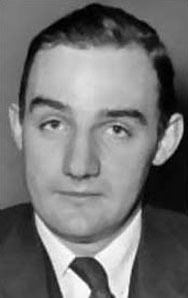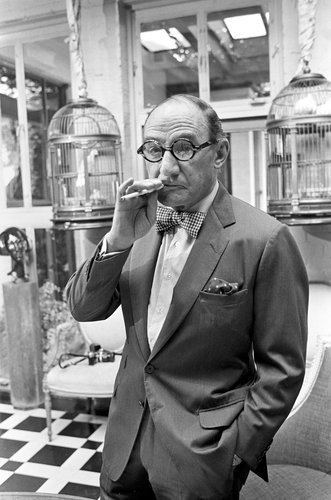Name Joseph Alsop | Siblings Stewart Alsop | |
 | ||
Parents Joseph Wright Alsop IV, Corinne Alsop Cole Books The Rare Art Traditions, I've seen the best of it, FDR - 1882‑1945: a Centen, From the silent earth, The 168 days Similar People Stewart Alsop, Stewart Alsop II, Corinne Roosevelt Robinson, Turner Catledge, Elizabeth Winthrop | ||
Joseph Alsop Quotes
Joseph Wright Alsop V (October 10, 1910 – August 28, 1989) was an American journalist and syndicated newspaper columnist from the 1930s through the 1970s. His influential journalism and status as a top insider in Washington was prominent from 1945 to the late 1960s, often in conjunction with his brother Stewart Alsop.
Contents
- Joseph Alsop Quotes
- Early life
- Journalism career
- Military service and CIA
- Personal life
- Sexuality
- In popular culture
- Publications
- References

Early life

Alsop was born on October 10, 1910, in Avon, Connecticut, to Joseph Wright Alsop IV (1876–1953) and Corinne Douglas Robinson (1886–1971). Through his mother, he was related to Presidents Theodore Roosevelt and James Monroe. Both of Alsop's parents were active in Republican politics. His father unsuccessfully sought the governorship of Connecticut several times, his mother founded the Connecticut League of Republican Women in 1917, and both served in the Connecticut General Assembly.

Alsop graduated from the Groton School, a private boarding school in Groton, Massachusetts, in 1928, and from Harvard University in 1932.
Journalism career

After college, Alsop became a reporter, then an unusual career for someone with an Ivy League diploma. He began his career with the New York Herald Tribune and fast established a substantial reputation as a journalist, particularly by his comprehensive reportage of the Bruno Hauptmann trial in 1934.
Because of his family ties to the Roosevelts, Alsop soon became well-connected in Franklin Roosevelt's Washington. By 1936, The Saturday Evening Post had awarded him a contract to write about politics with fellow journalist Turner Catledge. Two years later, the North American Newspaper Alliance (NANA) contracted Alsop and Robert E. Kintner to write a nationally syndicated column on a daily basis. His first book The 168 Days (1938), covering Roosevelt's unsuccessful campaign to enlarge the Supreme Court, became a bestseller. In 1940 Alsop and Kintner moved from NANA to the New York Herald Tribune.
In 1941, after it had become clear that the United States would soon enter World War II, Alsop and Kintner suspended their column and volunteered for the armed forces. After the war, Alsop resumed his journalism career, now working with his brother Stewart to produce a thrice-weekly piece, called "Matter of Fact", for the Herald Tribune. The use of the word "fact" reflected Alsop's pride in producing a column based on reporting, rather than the opinion pieces of many other columnists. Stewart remained headquartered in Washington to cover domestic politics, and Joseph traveled the world, covering foreign affairs. Their partnership lasted from 1945 until 1958, when Joseph became the sole author of "Matter of Fact" until his retirement in 1974.
The Alsops once described themselves as "Republicans by inheritance and registration, and... conservatives by political conviction." Despite his identity as a conservative Republican, however, Alsop was an early supporter of the presidential ambitions of Democrat John F. Kennedy and became a close friend and influential adviser to Kennedy after his election, in November 1960. Alsop was a vocal supporter of America's involvement in Vietnam, which led to bitter breaks with many of his liberal friends and a decline in the influence of his column.
Military service and CIA
Alsop entered the US Navy and used his political connections to be assigned as Staff Historian to Claire Lee Chennault's American Volunteer Group, later famous as the Flying Tigers, while the group was training at Toungoo, Burma. While on a supply mission for Chennault late in the fall of 1941, he found himself in Hong Kong on December 7. Unable to secure passage out of the city, Alsop was eventually taken into custody as an enemy alien and interned at Hong Kong by the Japanese. He was after six months repatriated through a prisoner exchange as a journalist, but he had really been a combatant, a fact he managed to conceal by changing into civilian clothes and with the help of friends. He traveled back to the United States on the neutral liner Gripsholm. He returned to China as a civilian Lend-lease administrator in the fall of 1942, assigned to the wartime capital, Chungking. He eventually rejoined Chennault in Kunming, China and served with him for the remaining months of the war.
In subsequent years, Alsop also helped the CIA in its intelligence-gathering activities, using his status as a foreign correspondent as cover. In 1953, Alsop covered Philippine elections at the CIA's request.
Personal life
In 1961, he married Susan Mary Jay Patten, a descendent of John Jay and the widow of William Patten, an American diplomat who was one of Alsop's friends. By this marriage he had two stepchildren, William and Anne. The couple divorced in 1978.
A noted art connoisseur and collector, Alsop delivered six lectures at the National Gallery of Art in Washington on The History of Art Collecting in the summer of 1978.
He was at work on a memoir when he died at his home in the Georgetown section of Washington, D.C., on August 28, 1989. He is buried at Indian Hill Cemetery, Middletown, Connecticut. The memoir was published posthumously as I've Seen the Best of It.
Sexuality
Alsop kept his homosexuality a closely guarded secret all of his life. Richard Helms called him "a scrupulously closeted homosexual".
Nevertheless, Senator Joseph McCarthy insinuated that Alsop was homosexual in the course of a dispute with The Saturday Evening Post about its coverage of his campaign to remove "perverts" from government employment. When McCarthy implied that Alsop was not "healthy and normal", a Post editor vouched for him: "I know Alsop well, and I know he is a man of high character, with great courage and integrity."
Early in 1957, the KGB photographed him in a hotel room in Moscow having sex with another man, a Soviet agent. He rebuffed Soviet attempts at blackmail, instead writing "a detailed account of the incident and a relevant narrative history of his sex life". It has been described as "brimming with revelations about Alsop's sex life on several continents", including a report that one of his lovers was Arthur H. Vandenberg, Jr., who had resigned as Dwight Eisenhower's appointments secretary in 1953. His accounts, delivered to a friend in the CIA, quickly reached the FBI, allowing J. Edgar Hoover to spread the information through the Eisenhower administration, many of whose members had fought sharp battles with Alsop.
Hoover told President Lyndon B. Johnson about the Moscow incident in 1964, and Johnson told Secretary of Defense Robert S. McNamara about Alsop's FBI file.
In 1965, Alsop complained to friends that Johnson was tapping his phone, a claim that infuriated Johnson, who believed that he protected Alsop from McCarthy's attacks years before. Alsop told White House Press Secretary Bill Moyers that he believed the Administration was tapping his phone and spreading gossip about his personal life, all in an attempt to stop leaks.
When Moyers reported the charges to the President, Johnson ordered Attorney General Nicholas Katzenbach to be certain no such wiretap was in place and protested that he never ordered one: "I'm as innocent of it as I am of murdering your wife", he told Katzenbach.
In the 1970s, the Soviets sent Alsop's embarrassing photos to several prominent American journalists without adverse consequences. Alsop even considered making his homosexuality public to end the harassment, but ultimately did not.
In popular culture
John Steinbeck references Alsop in Travels with Charley (1962), calling him a "justly famous critic of places and events".
In Gore Vidal's novel Washington, D.C. (1967), the character of a gay journalist is loosely based on Alsop.
Sheep on the Runway, a play by humorist Art Buchwald, satirized Alsop as an obsessive war correspondent. The play opened at the Helen Hayes Theatre and ran from January 31 to May 2, 1970.
David Auburn's play The Columnist, which ran on Broadway from April 25 to July 8, 2012, dramatizes Alsop's life, notably the interplay of his politics, his journalism, and his sexuality.
